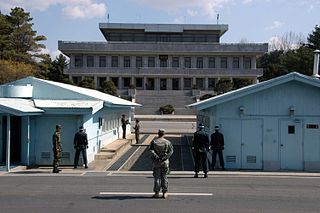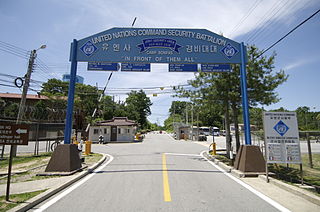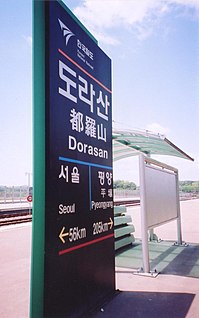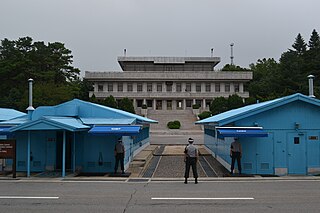 W
WThe Korean Demilitarized Zone is a strip of land running across the Korean Peninsula near the 38th parallel north. The demilitarized zone (DMZ) is a border barrier that divides the Korean Peninsula roughly in half. It was established to serve as a buffer zone between the countries of North and South Korea under the provisions of the Korean Armistice Agreement in 1953, an agreement between North Korea, China and the United Nations Command.
 W
WCamp Bonifas is a United Nations Command military post located 400 m (1,300 ft) south of the southern boundary of the Korean Demilitarized Zone. It is 2,400 m (7,900 ft) south of the Military Demarcation Line, which forms the border between South Korea and North Korea. It was returned to the Republic of Korea in 2006.
 W
WDaeseong-dong is a village in South Korea close to the North Korean border. It lies within the Korean Demilitarized Zone (DMZ). The village is about 1.6 kilometers south of the Bridge of No Return, and 12 km from the city of Kaesong, North Korea. As of 2018, the village has 193 inhabitants.
 W
WDorasan or Mount Dora is a 156-metre hill on the north bank of the Imjin River in northernmost Paju, South Korea. It lies very near the Korean Demilitarized Zone. The hill gives its name to several nearby landmarks, including Dorasan Station and the Mt. Dora Observatory, as well as to the local administrative unit Dorasan-ri.
 W
WDorasan station is a railway station situated on the Gyeongui Line, which used to connect North Korea and South Korea and has since been restored. Dorasan station is located approximately 650 meters from the southern boundary of the Korean Demilitarized Zone and is currently the northern terminus of Korail's Gyeongui Line, which is served by Tonggeun commuter trains. North of here the former Gyeongui Line continues as the Korean State Railway's P'yŏngbu Line, but this connection is not in regular service. The current purpose of the station is largely symbolic of the hope for eventual Korean reunification.
 W
WThe Joint Security Area is the only portion of the Korean Demilitarized Zone (DMZ) where North and South Korean forces stand face-to-face. The JSA is used by the two Koreas for diplomatic engagements and, until March 1991, was also the site of military negotiations between North Korea and the United Nations Command (UNC).
 W
WKijŏng-dong, Kijŏngdong, or Kijŏng tong is a supposed village in P'yŏnghwa-ri, Kaesong-si, North Korea. It is situated in the North's half of the Korean Demilitarized Zone (DMZ). Also known in North Korea as Peace Village, it has been widely referred to as 'Propaganda Village' by those outside North Korea, especially in South Korean and Western media.
 W
WThe Korean DMZ Conflict, also referred to as the Second Korean War by some, was a series of low-level armed clashes between North Korean forces and the forces of South Korea and the United States, largely occurring between 1966 and 1969 at the Korean DMZ.
 W
WThe Military Demarcation Line (MDL), sometimes referred to as the Armistice Line, is the land border or demarcation line between North Korea and South Korea. On either side of the line is the Korean Demilitarized Zone (DMZ). The MDL and DMZ were established by the Armistice.
 W
WThe Neutral Nations Supervisory Commission (NNSC) was established by the Korean Armistice Agreement signed 27 July 1953, declaring an armistice in the Korean War. It is, with the Military Armistice Commission, part of the mechanism regulating the relations between the Democratic People's Republic of Korea and the Republic of Korea.
 W
WOn 23 January 1968 North Korean patrol boats supported by two Mikoyan-Gurevich MiG-21 fighters captured the USS Pueblo northeast of the North Korean island of Ung-do. The seizure of the Pueblo led to President Lyndon Johnson ordering a show of force with a massive deployment of U.S. air and navy assets to Korea. The airlift and deployment of 200+ aircraft was code named Operation Combat Fox while the deployment of six aircraft carriers plus support vessels was code named Operation Formation Star. The operations were supported by the partial mobilization of reservists for the first time since the Cuban Missile Crisis. CIA A-12 Oxcart reconnaissance overflights over North Korea were used to monitor a feared retaliatory mobilization of North Korean forces and when these flights revealed no mobilization or large scale deployments by North Korean forces, Operation Combat Fox forces were stood down.
 W
WPanmunjom, also known as Panmunjeom, now located in Paju, Gyeonggi Province, South Korea or Kaesong, North Hwanghae Province, North Korea, was a village just north of the de facto border between North and South Korea, where the 1953 Korean Armistice Agreement that paused the Korean War was signed. The building where the armistice was signed still stands.
 W
WThe Third Tunnel of Aggression is one of four known tunnels under the border between North Korea and South Korea, extending south of Panmunjom.
 W
WThe United Nations Command Military Armistice Commission (UNCMAC) was established in July 1953 at the end of the Korean War to supervise the Korean Armistice Agreement, and which has been operating ever since.
 W
WWomen Cross DMZ (WCDMZ) is a non-profit organization mobilizing women around the world to promote peace in Korea, as well as denuclearization and demilitarization of the Korean Peninsula. Founded in 2014 by Christine Ahn, a Korean American peace activist, the advocacy and education organization of feminists, lawyers and peace activists calls for a formal end to the Korean War and the replacement of the armistice agreement with a peace agreement. In 2015, WCDMZ made international headlines when it organized a historic crossing of the heavily armed De-Militarized Zone (DMZ) that separates North Korea from South Korea at the 38th parallel.